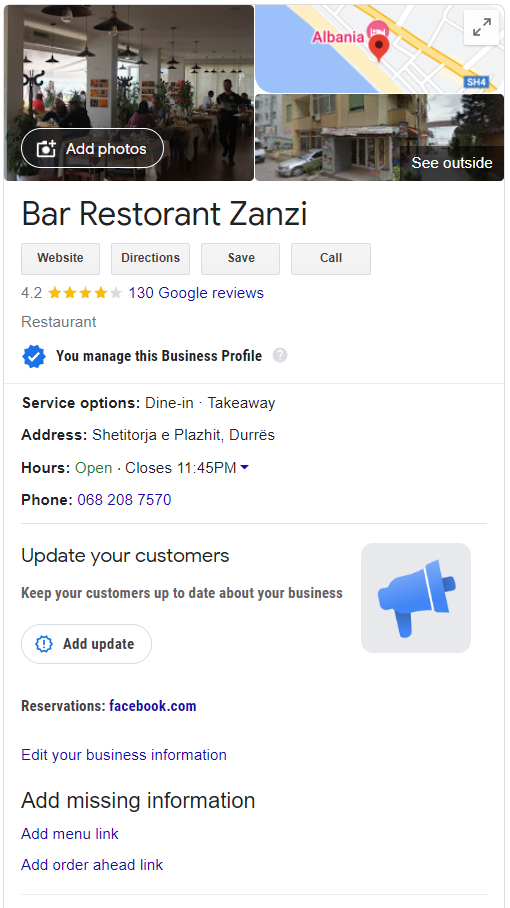If you own a restaurant, you need a strong online presence so customers can quickly and easily find you across multiple platforms. Restaurant SEO is a way to boost your online presence for potential customers to find your restaurant. With online ordering and food delivery having disrupted the traditional restaurant model, an online profile isn’t optional.
Some statistics show that a restaurant with an online ordering system brings in 130% more revenue than one that has not. Also, online ordering is growing 300% faster than dining. Statistics show that 60% of diners look at a restaurant’s menu online, and 50% check the website.
That’s why restaurant owners have started to invest time in restaurant SEO to make sure their restaurant appears on Google or other search engines.
For many of you, SEO may sound technical, but with some simple practices, you can turn your online presence into a traffic driver for your restaurant.
But what is SEO?
SEO stands for search engine optimization. It improves and optimizes your website to appear in search results on different search engines like Google, Yahoo, etc., for other terms related to your business. Search engine optimization aims to drive more traffic to your website – more traffic, more potential customers.
If your website is optimized for the same terms people are searching for, it will appear on the first page for those keywords (key phrases). This will make people more likely to click on your website and visit your restaurant in person (especially if you have online ordering and reservations on your website).
What are the benefits of SEO for restaurants?
The process of search engine optimization (SEO restaurant) may take you a lot of time and energy, but there are significant benefits that can improve your overall restaurant marketing strategy. Your marketing strategy will help new customers find your restaurant easily and learn more about it.
Seven Restaurant SEO tips to help your website rank #1
With hundreds of tips out there that can probably make their website rank higher in search results, it is hard to find exactly what goes into that #1 spot.
Anyway, Google has given a pretty good idea of the core strategies that you can use to optimize websites. Below you will find some advice SEO experts use themselves and the best tips for your restaurant.
1.Create a keyword planning roadmap.
Building out your restaurant SEO roadmap with keyword planning is the first thing you should do. Keyword planning is releasing the target keywords you want your restaurant’s website to rank for. Such terms can be single words, but they include 2, 3, or more words more likely. Next, you can use a free keyword planning tool to help you brainstorm other search terms (keywords) similar to the ones you have already laid out. Google Keyword Planner, Dragon Metrics, and SEMrush are free keyword planning tools that can help you prioritize specific keywords over others based on the average of people searching for that term every month.
When searching keywords, keep in mind to break out your targets into these three types of keywords:
- High-intent broad restaurant terms – very broad but valuable keywords
- Niche keywords – specific keywords to what your restaurant offers
- Branded keywords – related keywords and optimizing for the name of your restaurant
To find relevant keywords, here is what you have to do:
- First, brainstorm and list out the most impactful terms for your restaurant.
- Then verify what people are searching for via keyword planning tools.
- After, please make a list of your current potential customers and identify your potential customer’s pain points (for each one of them).
- In the end, look for specific keywords for this demographic.
All you have to do is compare terms in keyword research tools and make sure you optimize for the right keywords (ones that are being searched).
2.Optimize for Local SEO.
Within two years (2004-2006), Google changed its results for local searches and results from searches with location-based intent (i.e., searching for a particular business in a specific city/town). And this is the reason why location-based search always delivers results with the Google Map carousel feature.

An excellent method to optimize these results is simply adding your restaurant website to all social media platforms, restaurant review sites, and directories with the same standardized company information.
You can add your business information to pages like Google My Business, Yelp, TripAdvisor, Foursquare, Yellowpages, etc.

This can help you build your brand presence and identity and show Google that your restaurant is a reputable business. Plus, it will act as a form of defense against your biggest competitors in the local space – since your restaurant may appear before theirs in search results.
3.List your restaurant on review sites & encourage reviews
Based on different studies, having reviews in search results increases those pages’ click-through rate (CTR). Once again, more traffic, more potential customers.
It is important to know that reviews are also an indicator for Google when ranking search results. You also need to know that Google shows the highest-rated restaurants/businesses in many local search results. Plus, Google shows your restaurant’s rating right on the search results page, helping you attract many new customers to your restaurant.
According to some reports, 68% of restaurant customers said they visited a new entirely based on positive online reviews, and that’s a lot of new traffic! So you need to work hard and focus more on getting more reviews.
4.Get other websites to link to your restaurant’s website.
Online reviews can help your restaurant with link building, an important factor in search optimization. Generally speaking, link building is the strategy of getting other websites to link back to yours. Link building strategy is important because when other websites link to your restaurant’ website, it acts as a sign of belief from that website. It also signals to Google that your website is authority and reputable on whatever topic the linked web page is about,
In simple terms, the more link you have from reputable sites, the more you will appear in searches for your key terms (keywords).
5.Make your site mobile-friendly.
According to some statistics, in 2018, more than 80% of the population used a mobile device to surf the Internet, and with time, that number continued to grow. Of course, people also use their laptops and desktop computers for browsing, but most traffic comes from mobile devices.
So, based on this mobile trend, in 2018, Google made a large switch to its search formula. So, nowadays, the mobile view of your website is a lot more important than your desktop view. And that means that any website that is not mobile-friendly is less likely to appear in search results.
To be sure your website is mobile-friendly, you have to pre-confirm with the person who builds (or updates) your site that your design and the content on each page adjust to the screen size of the visitor’s device.
Remember: Now, many popular WordPress themes come within pre-packaged responsive frameworks which help your web pages appear optimized for mobile and desktop visitors.
6.Test your online ordering system.
As online ordering has increased, many restaurants have now added an online ordering system to their site. Apart from having online ordering, you have to make sure you have an easy-to-use system for diners to place an order. Otherwise, they will abandon their cart and go for a simpler ordering system in another restaurant.
And this bad ordering experience will cost you a loss of revenue and customers for businesses, but it will also hurt your search results. Google can easily recognize when a user is frustrated with a service and leaves a page.
Know that Google or other search engines prioritize pages and websites with lower bounce rates.
And this is where user testing comes to play. Whether you build your ordering system or outsource it to a site builder (or UX designer), the most important is to ensure that many people go through the ordering process, step by step and day-by-day.
You have to make sure the ordering process is smooth and doesn’t create confusion or frustration for your customers.
7.Launch a blog for your restaurant.
Launching a blog can help you improve search rankings, increase your customer base, and drive more traffic. But, when writing about a restaurant’ blog, you need to get a little creative.
You can write about different topics that are relevant and important to your restaurant’s mission statement. For example, you could write about locally sourced ingredients, community involvement, the restaurant’s specialty, etc.
You can also use your restaurant’s blog to promote a new marketing campaign or launch a new pop-up restaurant.
I hope you enjoyed this article, and these seven tips will help you drive new revenue and awareness to your restaurant. With these tips, you can also build a strong foundation for your restaurant SEO, so you only have to learn to handle all the extra traffic that will come through your doors.




